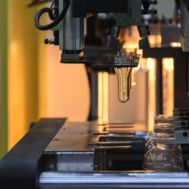
Industries

Applications

Cookie Consent
Cookies are used for statistical purposes and to improve the site.
Cookies will be used after you click "Accept" or if you continue using Dynisco.com
To find out more please review our Privacy Policy.
Here, you can learn about product specifications and benefits, download our searchable full line product catalog, read a story on how a particular customer’s business was improved by our product, or deepen your technical understanding of our products’ uses and applications.

The present work aims to describe the design of the on-line rheometer and how it can be easily connected to the extruders using existing ports and flexible adapters. It also has been explained how the proposed on-line rheometer can duplicate the test conditions of an off-line melt flow rate tester on an extruder in any compounding or manufacturing process. Furthermore, through calculation of activation energy in a specific material and introducing a temperature correlation, it has been investigated how the on-line rheometer considers the temperature dependency of material`s MFR and accurately measures this parameter at various operating temperatures.
Though often criticized, MFR is a very good gauge of the relative average molecular weight of the polymer. Since molecular weight (MW) is the driving force behind performance in polymers, it turns out to be a very useful number.
To fully appreciate the strengths and weaknesses of the melt-flow-rate (MFR) test it is important to know something about the way the test is performed.
There is a well-established relationship between something called the weight average molecular weight of a polymer and a parameter known as the zero-shear viscosity.
Few molders perform the test in-house. Of those that do, most don't understand why they are doing it or what they are measuring.
There are two points in the manufacturing supply chain where a determination of average molecular weight (MW) is important. The first is when the material is first received by the molder. The second is after molding.
Once degradation has been established, the discussion inevitably turns to how it happened. It might be expected that the answer to this question is widely known. Not so. The good news is that the influences that cause polymer degradation during processing are few.
Here is why the melt flow test is not universal. As useful as the melt flow rate (MFR) test can be, it is not universally applicable. Fundamentally, the test is intended to document differences in molecular weight.
Here are the steps to take in cases where the MFR is not provided by the polymer supplier. The number of commercial materials that employ a melt flow rate (MFR) value as part of the published property profile attests tO the usefulness of the test.
Understanding the value of melt-volume rate. If you spend a lot of time looking at data sheets you have probably noticed a trend over the last several years in how the melt flow rate (MFR) is reported. Along with, or instead of, the MFR, a new line item is appearing called the melt volume rate (MVR).
Check out a recent interview with Dynisco's Johannes Lorenz where he discusses inline viscosity measurement in PET and polyolefin recycling.
Divided into 3 sections, obtain a general understanding of pressure transducer basics, the types of plastic extrusion, and the benefits of pressure transducers.

38 Forge Parkway,
Franklin MA 02038
+1 508 541 9400
Pfaffenstr. 21, 74078,
Heilbronn, Germany
+49 7131 297 0
Lot 3615, Jalan SM 6/8
32040 Seri Manjung, Perak, Malaysia
+605 6884014